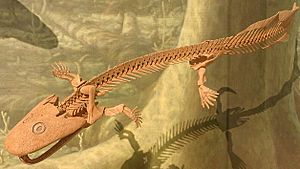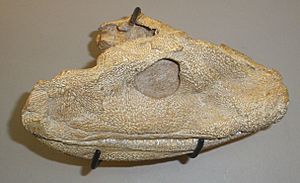Acanthostega facts for kids
Quick facts for kids AcanthostegaTemporal range: Devonian 365 mya
|
|
|---|---|
 |
|
| Acanthostega gunnari skeleton reconstruction | |
| Scientific classification | |
| Kingdom: | |
| Phylum: | |
| Subphylum: | |
| Superclass: | |
| Class: | |
| Binomial name | |
| Acanthostega gunnari Jarvik, 1952
|
|
| Tetrapodomorpha | |
Acanthostega (say "A-can-tho-STAY-ga") means 'spiny roof'. It was an ancient animal that lived about 365 million years ago. It was a type of fishapod, which means it was somewhere between a fish and a tetrapod (an animal with four limbs). Acanthostega was one of the first animals to have clear limbs, even though it spent most of its life in water.
Contents
What Was Acanthostega Like?
Acanthostega had eight fingers on each front "hand" and six toes on each back "foot". These digits were connected by webbing, like a duck's foot. It did not have wrists that could support its body weight on land. Its front limbs could not bend forward at the elbow, so they weren't good for walking. Instead, they were perfect for paddling in water or holding onto plants.
Even though it had lungs, its ribs were too short to support its chest out of water. It also had gills like a fish, which were covered, not open like some modern amphibians.
Scientists used to think that animals first crawled onto land and then grew legs. But the discovery of Acanthostega changed this idea. It showed that animals developed legs and feet while they were still living mostly in water. Later, they used these limbs for walking on land.
The bones in Acanthostega's hips (called the pelvic girdle) were different from its fish ancestors. In fish, the two sides of the hip bones were not connected. But in Acanthostega, they touched and were joined to the backbone. This made its hips stronger, helping it deal with gravity when not floating in water.
Because of these features, paleontologists (scientists who study fossils) believe Acanthostega probably lived in shallow, swampy areas filled with plants. Its legs were likely used for something other than walking on land, maybe for moving through thick weeds.
Its teeth were also different from fish. It had a few large teeth on the outside and smaller teeth on the inside of its jaw. Research suggests that Acanthostega might have bitten its prey directly, like land animals do. This supports the idea that this "land-style" feeding first appeared in water animals. This means Acanthostega was specially made for hunting in shallow water, right at the edge of land.
How Was Acanthostega Discovered?
Small pieces of the skull were first found in 1933 by Gunnar Säve-Söderbergh and Erik Jarvik. But the most important fossils, which showed how special this animal was, were discovered by Jenny Clack in East Greenland in 1987.
Related Species
Acanthostega is part of a big wave of evolution that happened in the late Devonian period. This started with fish-like animals that had fins. Over time, their descendants began to breathe more air and developed stronger jaws and necks. They also used their fins to lift their bodies.
These changes can be seen in earlier animals like Tiktaalik. Like Acanthostega and Ichthyostega, Tiktaalik is also thought to have lived mostly in water.

Related pages
Images for kids
See also
 In Spanish: Acanthostega para niños
In Spanish: Acanthostega para niños



